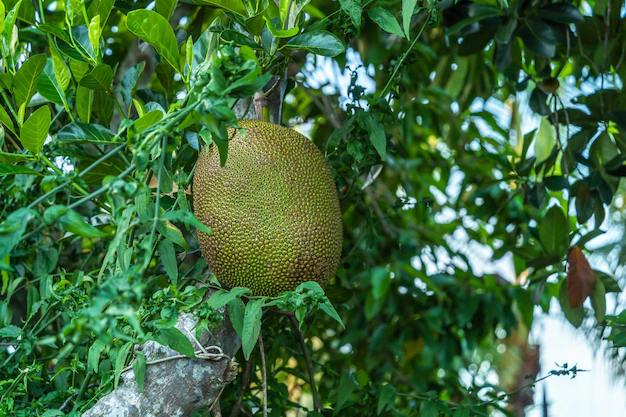
Jackfruit, known for its enormous size and unique flavor, is a tropical fruit that has gained popularity in recent years. If you have a green thumb and are interested in growing your own jackfruit tree, this comprehensive guide is here to help. Whether you’re a beginner or an experienced gardener, these tips and tricks will ensure a successful harvest of this delicious fruit.
Understanding the jackfruit tree
Before diving into the details of planting a jackfruit tree, it’s important to understand the tree itself. Jackfruit trees are native to tropical regions and require a warm climate to thrive. They can grow up to 80 feet tall and have a broad, spreading canopy. The fruit is typically large, weighing anywhere from 10 to 100 pounds. Jackfruit trees are also known for their durability, with some trees living for over 100 years.
Choosing the right location for planting
When selecting a location for your jackfruit tree, it’s essential to consider its size and growth habits. These trees require full sun exposure, so choose a spot that receives at least six to eight hours of direct sunlight each day. Jackfruit trees also need well-drained soil, as they are susceptible to root rot in waterlogged conditions. Additionally, ensure that the chosen area has enough space for the tree to grow to its full size without any obstructions.
Preparing the soil for jackfruit planting
Preparing the soil is a crucial step in ensuring the successful growth of your jackfruit tree. Start by clearing the area of any weeds or vegetation. Then, dig a hole that is twice as wide and deep as the root ball of your sapling. Mix in organic matter such as compost or well-rotted manure to improve soil fertility and drainage. It’s also beneficial to perform a soil test to determine the pH level and make any necessary adjustments to create the ideal growing conditions for your jackfruit tree.
Selecting and purchasing jackfruit seeds or saplings
When it comes to choosing jackfruit seeds or saplings, it’s best to opt for grafted varieties as they tend to be more reliable and produce fruit sooner. You can find these at local nurseries or online garden centers. Look for healthy saplings with a well-developed root system. If you prefer starting from seeds, select ripe jackfruit fruits and extract the seeds. Keep in mind that it may take several years for a tree grown from seeds to bear fruit.
Planting jackfruit seeds or saplings
Once you have your jackfruit seeds or saplings ready, it’s time to plant them. Dig a hole in the prepared soil that is wide and deep enough to accommodate the roots. Place the sapling or seed in the hole, ensuring that the top of the root ball is level with the soil surface. Gently backfill the hole with soil, firming it around the base of the tree. Water the newly planted tree thoroughly to settle the soil and provide moisture for the roots.
Watering and fertilizing jackfruit trees
Proper watering is crucial for the healthy growth of jackfruit trees. While they are relatively drought-tolerant, young trees require regular watering until they establish a strong root system. Water deeply once or twice a week, allowing the soil to dry out slightly between waterings. During the dry season, increase the frequency of watering. Fertilize your jackfruit tree every three months with a balanced fertilizer to ensure it receives the necessary nutrients for optimal growth.
Pruning and maintaining jackfruit trees
Regular pruning is essential for maintaining the shape and productivity of jackfruit trees. Begin pruning when the tree is young to encourage a strong structure. Remove any dead, diseased, or damaged branches and thin out excessive growth to allow for better air circulation. Prune your tree during the dormant season to minimize stress. Additionally, provide support for the heavy branches as the tree grows to prevent them from breaking under the weight of the fruit.
Dealing with common pests and diseases in jackfruit trees
Like any plant, jackfruit trees can be prone to certain pests and diseases. Common pests include aphids, mealybugs, and fruit flies. Monitor your tree regularly and take action at the first sign of infestation. Use organic insecticides or insecticidal soaps to control pests. As for diseases, the most common are root rot and anthracnose. Ensure proper drainage and avoid overwatering to prevent root rot. Apply copper-based fungicides to control anthracnose and other fungal diseases.
Harvesting and storing jackfruit
The moment you’ve been waiting for has arrived—it’s time to harvest your jackfruit! The fruit is ready to be picked when it turns from green to yellowish or brownish and gives off a sweet aroma. Cut the fruit carefully using a sharp knife or pruning shears, leaving a short stem attached. To store jackfruit, wrap each piece in newspaper or place them in a perforated plastic bag and store them in the refrigerator. Jackfruit can stay fresh for up to a week when refrigerated.
Jackfruit recipes and culinary uses
Now that you have a bountiful harvest of jackfruit, it’s time to explore its culinary uses. Jackfruit is a versatile fruit that can be used in both savory and sweet dishes. It has a meaty texture and a mild, slightly sweet flavor. Some popular recipes include jackfruit curry, jackfruit tacos, and jackfruit ice cream. Experiment with different recipes and let your creativity shine in the kitchen.
Conclusion: Enjoying the fruits of your labor
Growing jackfruit trees can be a rewarding experience. With the right knowledge and care, you can have a thriving tree that yields delicious fruits for years to come. Remember to choose the right location, prepare the soil, and provide adequate water and nutrients. Don’t forget to tackle any pests or diseases that may arise. Finally, savor the taste of your homegrown jackfruit and share your culinary creations with family and friends. Happy planting and harvesting!






